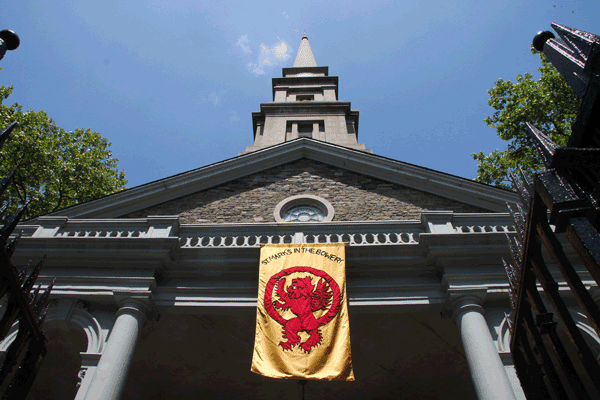 [/media-credit]
[/media-credit]
You can vote for your favorite place once a day from now until May 21 by registering at www.partnersinpreservation.com. The top three vote-getters would get their preservation projects funded.
“Of course, I hope we win, but all the places have great history and deserve a share in the prize,” said Roger Walters, the junior warden of the St. Mark’s vestry and historian of the church on E. 10th St. and Second Ave.
St. Mark’s Church was built in 1795 and has gone through renovations and changes over the years, including after a devastating 1978 fire.
St. Mark’s is asking Partners in Preservation to fund the repair and restoration of the cast-iron portico over the E. 10th St. front porch.
“It was built in 1858 when cast iron was all the rage,” said Walters. The design is attributed to James Bogardus, an early proponent of cast-iron construction. “Three years ago there was an attempt to restore the portico, but it needs to be stripped, cleaned and we might have to replace corroded sections,” Walters said during a Sunday open house tour last week. The final cost of restoring the portico is hard to estimate before any work begins, but it could run between $250,000 and $300,000, Walters added.
Reverend Winnie Varghese, who became rector of St. Mark’s three years ago, said the diverse congregation has been growing and is now three times what it was when she started.
The state’s legalization of same-sex marriage last year was an important milestone for St. Mark’s. The church’s first ceremony for a gay marriage took place on Sept. 10, 2011.
“We had done blessings for partners before, but that was the first marriage,” Varghese said.
St. Mark’s had lost its mission as a church for a few years and no one took care of the building, said Varghese.
“We had hoped our resident arts groups would take a lead in the preservation, but that didn’t happen,” she said. “Now we’re reclaiming our identity as a strong, progressive congregation and we’re able to take responsibility for it,” she added.
The church and its yards are what’s left of the extensive “bouwerie” (plantation) that the New Amsterdam governor, Peter Stuyvesant, bought in 1651 from the Dutch West India Company. He built a Dutch Reformed chapel on the site in 1660 for plantation workers and their families, and his body was interred in a vault under the chapel when he died in 1672.
His great-grandson, Petrus Stuyvesant, donated the property in 1773 to the Episcopal Church with the stipulation that a new chapel be erected. The cornerstone was laid on April 25, 1795.
The steeple, designed by Martin Euclid Thompson and Ithiel Towne, was erected in 1828 and the cast- and wrought-iron fence attributed to Thompson was installed in 1838.
Two sculptures of Native Americans (“Aspiration” and “Inspiration”), carved by Solon Borglum, brother of the creator of Mt. Rushmore in South Dakota, were acquired in the 1920s by Rector Norman William Guthrie.
Under the East Yard and West Yard are vaults of prominent families who attended St. Marks in the 19th century. Among those buried within are Petrus Stuyvesant, the department store merchant A.T. Stewart, Nicholas Fish, Abraham Schermerhorn, Elizabeth Beekman, U.S. Vice President Daniel Tompkins — the namesake of Tompkins Square Park — and Mayor Philip Hone.
Partners in Preservation is a joint program of American Express and the National Trust for Historic Preservation, which has given $6.5 million since 2006 to preservation projects in San Francisco, Chicago, New Orleans, Boston, Seattle and Minneapolis-St. Paul.
The Lower East Side’s Tenement Museum is competing for a Partners grant to help preserve its 1863 tenement at 97 Orchard St. Apartments in the building, which remain much as the museum found them in 1988, have been untouched for about 50 years.
“They need to be carefully stabilized and preserved for future visitors without diminishing their historic integrity,” said Kira Garcia, the museum’s public relations manager.
The Jefferson Market Library, built between 1874 and 1877 on Sixth Ave. in the angle formed by Greenwich Ave. and W. 10th St., is also seeking a Partners grant to replace the entrance doors on Sixth Ave.
The Henry St. Settlement, whose offices are still located in its original 1832 federal row houses at 263, 265 and 267 Henry St., is also among the 40 contestants. The settlement is seeking funds to develop a model for a sustainable retrofitting of the original buildings.
The National Museum of the American Indian, in the U.S. Custom House at 1 Bowling Green, wants Partners in Preservation to fund the renovation of first-floor office space to create a classroom for the museum’s education program.
The High Line park also hopes to get Partners funding to restore the “Tenth Ave. Square” sunken overlook deck and to repair the stairway at that location. The New York Central railway viaduct — on which the new High Line park has been developed — was opened in 1933. The elevated railway was in use until the 1980s.

















